Handover Checklist Samples
-

Postoperative Handover Checklist
download now -

Patient Handover Checklist
download now -

Nursing Handover Checklist
download now -

Building Handover Checklist
download now -

Client Handover Checklist
download now -

Sample Handover Checklist Template
download now -

Product Handover Checklist
download now -

Project Handover Checklist
download now -
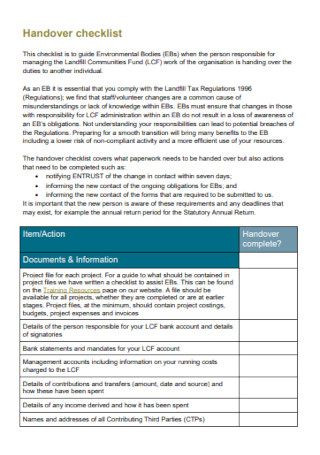
Basic Handover Checklist Template
download now -

Checklist for Job Handover
download now -

Residential Handover Checklist Template
download now -

Checklist of Typical Final Handover
download now -
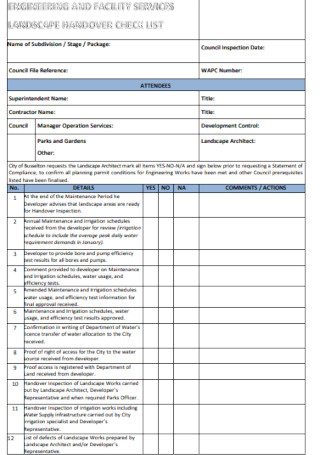
Landscape Handover Checklist
download now -

Store Manager Handover Checklist
download now -

Adoption Handover Checklist
download now -

Clinical Handover Checklist
download now -

Handover Checklist for Incoming Club
download now -

Pre-Site Handover Checklist
download now -

Built Handover Checklist
download now -

Room Handover Checklist Template
download now -

Handover Checklist for Outgoing Executive
download now -

Capital Project Handover Checklist
download now -

Anesthesiology Handover Checklist
download now -

Simple Handover Checklist Template
download now -

Handover Checklist and Report
download now -

Club Executive Handover Checklist
download now -

Handover and Discharge Checklist
download now -

Handover Inspection Checklist Example
download now -
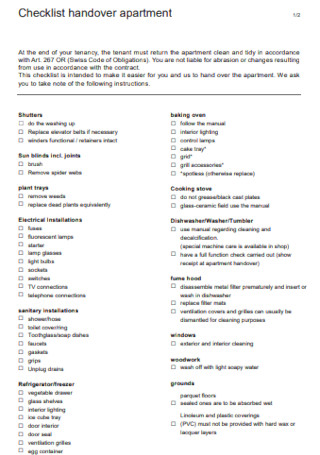
Apartment Handover Checklist
download now -

Standard Handover Checklist Example
download now -
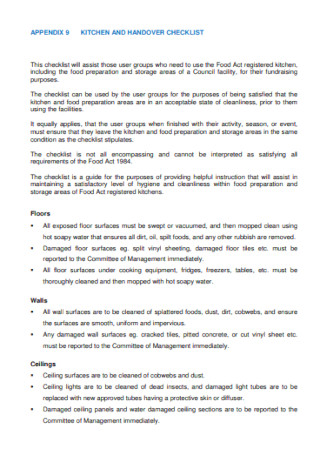
Kitchen and Handover Checklist
download now -

Handover Checklist Format
download now
FREE Handover Checklist s to Download
Handover Checklist Format
Handover Checklist Samples
What is a Handover Checklist?
Purposes of a Handover Checklist
Types of Handover Checklists
How to Create a Handover Checklist
FAQs
What is the objective of a handover document?
What are the basic reasons for handover?
What is a handover certificate?
When should a handover checklist be used?
What should be included in a handover checklist?
What are the common challenges when creating a handover checklist?
How do you ensure accountability with a handover checklist?
How often should a handover checklist be updated?

Download Handover Checklist Bundle
Handover Checklist Format
1. General Information
- Provide a summary of your role and responsibilities.
- Include a list of key contacts with their details (email, phone, etc.).
- Share access credentials or handover any required security passes.
2. Ongoing Tasks and Projects
- List all ongoing projects and their current status.
- Provide detailed instructions for each task in progress.
- Include deadlines and key milestones for each project.
3. Documents and Files
- Organize and share all relevant files and documents.
- Provide a list of shared drives or platforms used for file storage.
- Confirm all necessary documents have been backed up.
4. Tools and Software
- Provide a list of tools, software, and applications used.
- Include user manuals, guides, or tutorials for key tools.
- Ensure all necessary licenses or subscriptions are up to date.
5. Key Meetings and Events
- Share a calendar of upcoming meetings and events.
- Provide context and objectives for each meeting.
- Identify key stakeholders and their roles.
6. Reporting and Metrics
- Provide templates or examples of regular reports.
- Share performance metrics or KPIs relevant to your role.
- Include a schedule for when reports are due.
7. Challenges and Risks
- Highlight potential challenges or risks to ongoing tasks.
- Share strategies or solutions to address these issues.
- Include any unresolved issues and their status.
8. Feedback and Recommendations
- Provide suggestions for improvement in processes or workflows.
- Highlight areas of success that should be continued.
- Include any additional advice for the successor.
9. Final Handover
- Schedule a one-on-one handover meeting.
- Allow time for questions and clarifications.
- Confirm all items on the checklist are completed.
What is a Handover Checklist?
A handover checklist is a structured document that outlines all the critical information, tasks, and resources required for a smooth transfer of responsibilities. It acts as a guide for both the outgoing and incoming parties to ensure nothing is overlooked during the transition. Typically used in professional, project, or operational settings, it encompasses tasks like documentation sharing, role-specific instructions, and final deliverables. You can also see more on Office Checklist.
Purposes of a Handover Checklist
- Smooth Transition: Ensures tasks and responsibilities are seamlessly transferred without delays or confusion.
- Knowledge Preservation: Captures critical information to retain institutional expertise and support continuity.
- Error Prevention: Minimizes errors, missed tasks, and risks through systematic documentation.
- Operational Continuity: Maintains uninterrupted workflows and safeguards productivity during transitions.
- Clarity and Accountability: Provides clear guidelines, defines roles, and ensures transparency in the process. You can also see more on Employee Checklists.
Types of Handover Checklists
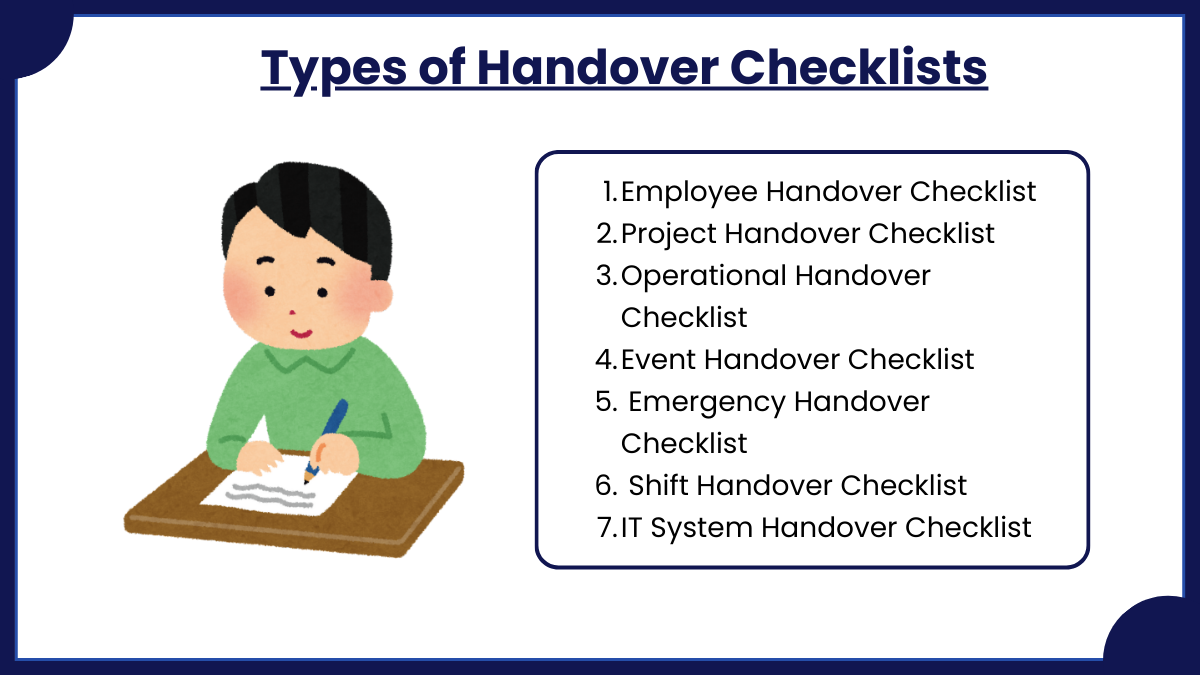
1. Employee Handover Checklist
This checklist is used when an employee leaves their role, whether due to resignation, retirement, or internal transfer. It includes details such as ongoing tasks, key contacts, access credentials, and important documentation to ensure their responsibilities are smoothly transitioned to another team member or a replacement. You can also see more on Move-in Checklists.
2. Project Handover Checklist
Designed for transferring project ownership to a new team or leader, this checklist covers project objectives, progress reports, deliverables, deadlines, and stakeholder information. It ensures that the new team has all the necessary resources to continue the project without disruptions.
3. Operational Handover Checklist
This checklist is used during shifts in operational processes, such as management changes or workflow adjustments. It focuses on documenting standard operating procedures, key systems, and any ongoing issues to maintain business continuity.
4. Event Handover Checklist
Commonly used in event management, this checklist ensures a smooth transition between teams handling different stages of an event. It includes information about timelines, vendor contracts, budgets, and task assignments, ensuring all aspects of the event are managed efficiently. You can also see more on Employee Exit Checklist.
5. Emergency Handover Checklist
This type of checklist is critical during unforeseen circumstances like sudden staff departures or emergencies. It contains essential information such as immediate action plans, critical contacts, and priority tasks to facilitate quick and efficient role handovers.
6. Shift Handover Checklist
Often used in industries like healthcare, manufacturing, or customer service, this checklist helps with daily or periodic transitions between shifts. It includes updates on ongoing issues, completed tasks, and pending work to ensure a seamless shift change. You can also see more on Turnover Checklist.
7. IT System Handover Checklist
Specifically for IT teams, this checklist documents technical details, system configurations, user credentials, and troubleshooting procedures when transferring responsibility for an IT system or infrastructure.
How to Create a Handover Checklist

Step 1: Understand the Scope of the Handover
Start by identifying the purpose of the handover. Determine whether it involves transitioning a role, project, or operational responsibility. Collaborate with relevant stakeholders to define key objectives. Understand the complexities and specific details that need to be documented, such as tasks, tools, and timelines. You can also see more on New Construction Checklist.
This foundational understanding ensures the checklist is tailored to the transition’s requirements, preventing oversights.
Step 2: List Key Responsibilities and Tasks
Draft a detailed list of all responsibilities and tasks to be handed over. Include ongoing projects, pending deliverables, and recurring duties. Break down complex roles into smaller, actionable items. Ensure the checklist is comprehensive by consulting the outgoing individual or team.
By capturing all tasks, this step minimizes disruptions and ensures continuity in operations.
Step 3: Gather Supporting Documentation and Resources
Compile all necessary documentation, tools, and access credentials. This may include user manuals, login details, templates, and operational guides. Organize these resources systematically, ensuring they are accessible to the incoming party. You can also see more on Building Construction Checklist.
Having all resources in one place reduces confusion and accelerates the onboarding process.
Step 4: Establish Timelines and Milestones
Set clear timelines for the handover process, detailing when specific tasks must be completed. Include milestones such as knowledge-sharing sessions, system handovers, and final approvals. Communicate these timelines to all parties involved to ensure alignment.
Defined deadlines maintain structure and help track progress effectively.
Step 5: Conduct a Handover Meeting
Organize a meeting to go through the checklist with the outgoing and incoming individuals or teams. Discuss responsibilities, clarify queries, and highlight critical tasks or challenges. Use the meeting to validate the completeness of the checklist and address any gaps. You can also see more on Construction Quality Control Checklist.
This interaction ensures mutual understanding and confidence in the handover process.
Step 6: Obtain Approvals and Finalize the Checklist
Once all items are completed, have the checklist reviewed and approved by relevant parties. The outgoing and incoming individuals, along with their supervisors, should sign off on the document. This step formalizes the process and ensures accountability.
A handover checklist is a cornerstone of effective transitions, ensuring that knowledge, tasks, and responsibilities are seamlessly transferred. By fostering collaboration, maintaining clarity, and minimizing errors, this tool enhances operational continuity. Whether in professional or project contexts, a well-prepared handover checklist reflects planning, accountability, and commitment to excellence. It’s an indispensable resource for smooth transitions. You can also see more on Payroll Checklists.
FAQs
What is the objective of a handover document?
A project handover template is a record that facilitates the transfer of a project between managers or an internal team and a client. Typically, these templates incorporate essential project details such as deliverables, scope, timetable, and milestones. You can also see more on Construction Cleaning Checklist.
What are the basic reasons for handover?
Low link quality causes handovers. Signal level and bit error rate are indicators of the quality of a link. The mobile phone and base station periodically measure the downlink and uplink quality of the present transmission link and the quality of channels in surrounding cells.
What is a handover certificate?
Typically, a handover certificate includes a list of items for which additional work is required. The transfer must be conducted formally and with an emphasis on safety. The plant should be in a specific state when it is transferred. You can also see more on Rental Property Checklist.
When should a handover checklist be used?
It is used during role changes, project transfers, employee exits, or operational shifts to ensure smooth transitions without gaps in responsibilities.
What should be included in a handover checklist?
Include tasks, responsibilities, documentation, deadlines, key contacts, and any other relevant details essential for the transition. You can also see more on Preoperative Checklist.
What are the common challenges when creating a handover checklist?
Challenges include incomplete documentation, lack of clarity in roles, and time constraints. Addressing these by involving all stakeholders can ensure a comprehensive and effective checklist.
How do you ensure accountability with a handover checklist?
Accountability is ensured by clearly documenting all tasks and obtaining sign-offs from the outgoing, incoming parties, and supervisors. This confirms the checklist’s accuracy and completeness. You can also see more on Document Checklists.
How often should a handover checklist be updated?
A handover checklist should be updated regularly to reflect changes in roles, projects, or operational needs. Frequent updates maintain its relevance and effectiveness during transitions. You can also see more on Equipment Checklist.
